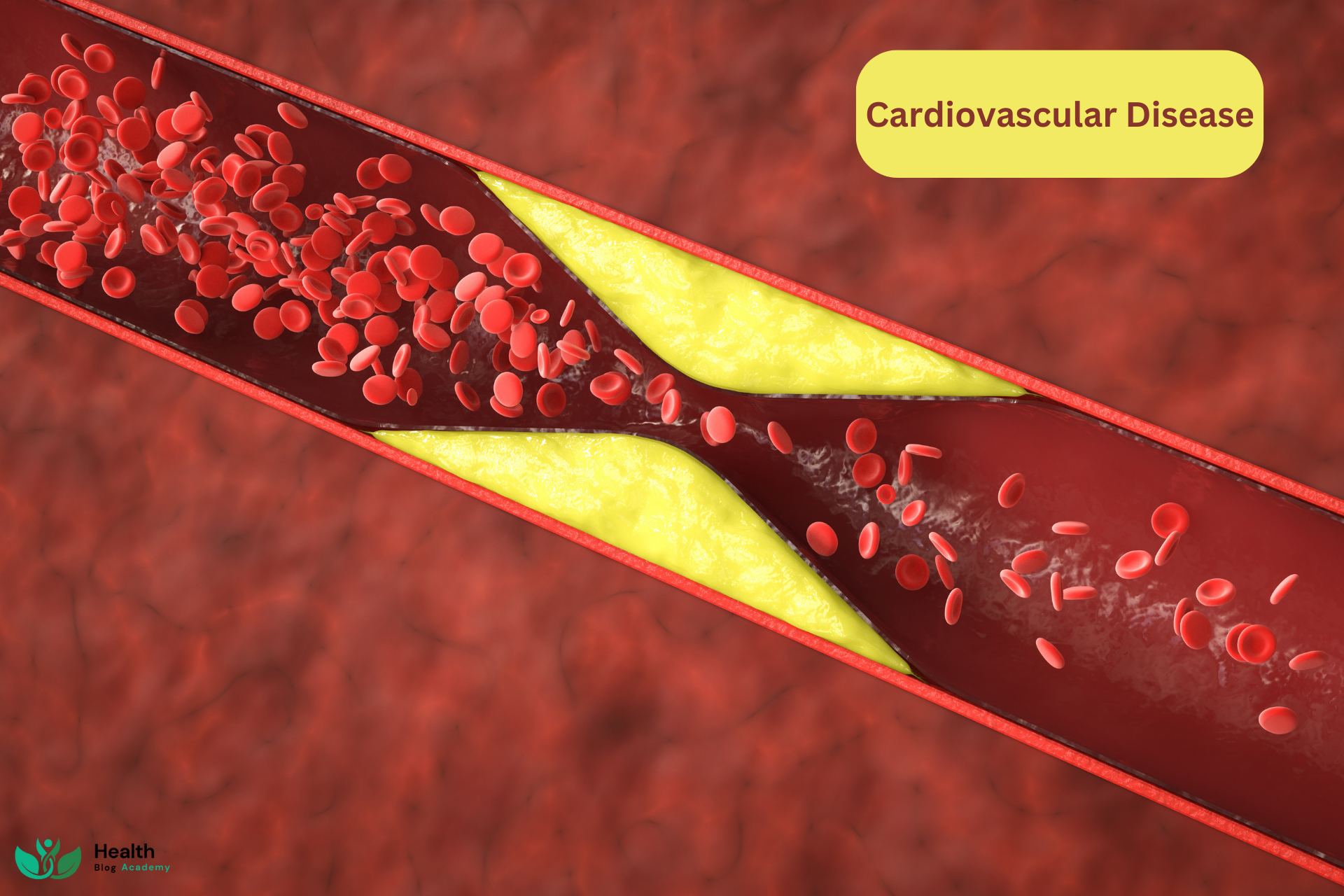Introduction
The phrase “heart disease” refers to a variety of ailments that have an impact on the heart and its operations. It is a widespread and severe health problem that has a considerable impact on morbidity and death globally. We will examine all facets of heart disease in this thorough guide, including its forms, causes, symptoms, diagnosis, therapy, prevention, and the significance of awareness.
Types of Heart Disease
Heart disease comes in a variety of forms, each having unique traits and effects on the circulatory system. We can better understand the intricacy of cardiac disease if we are aware of these types:
Cardiovascular Disease

The most prevalent kind of cardiac illness is coronary artery disease (CAD). It happens when plaque accumulation causes the coronary arteries, which carry blood to the heart muscle, to constrict or obstruct. Angina, heart attacks, and other consequences may result from this.
Heart disease
Congestive heart failure, also known as heart failure, is a condition that impairs the heart’s capacity to pump blood to the body’s tissues.
It may be brought on by a number of underlying conditions, including coronary artery disease, hypertension, or damaged heart valves.
Arrhythmias
Arrhythmias are abnormal heartbeats that may happen when there are issues with the electrical system of the heart. The heart may beat excessively quickly (tachycardia), too slowly (bradycardia), or irregularly as a result of them. While some arrhythmias are not dangerous, some may be.
Inborn Heart Defects
Structural flaws that are evident at birth are known as congenital heart defects. They may have an impact on the heart’s chambers, blood arteries, or valves. These flaws may need early medical intervention because they may impair the heart’s ability to pump blood normally.
Risk factors and the causes
A number of different causes and risk factors may contribute to the development of heart disease. Making decisions to prevent or treat heart disease may be made easier by being aware of the following factors:
Personal Choices
Heart disease is significantly influenced by unhealthy lifestyle choices. An increased risk of cardiac issues may result from a poor diet, a lack of exercise, a high alcohol intake, and drug misuse. Prioritizing a heart-healthy lifestyle requires adopting wholesome dietary practices, participating in regular exercise, and abstaining from dangerous drugs.
Blood pressure is high

A significant risk factor for heart disease is high blood pressure, sometimes known as hypertension. Consistently high blood pressure stresses the heart and blood vessels and raises the risk of issues connected to the heart. Heart health depends on regular blood pressure checks and heeding physician recommendations to control hypertension.
Elevated cholesterol
Blood with high cholesterol levels may develop plaque in the arteries, restricting them and obstructing blood flow. Atherosclerosis is a condition that greatly raises the risk of heart disease. It’s essential to keep your cholesterol levels in check with a balanced diet, frequent exercise, and, if required, doctor-prescribed medication.
Diabetes
Heart disease risk is considerably increased by diabetes, especially type 2 diabetes. Diabetes-related metabolic abnormalities may harm blood arteries and neurons, impairing the heart’s ability to beat normally. For those with diabetes, controlling blood sugar levels with a mix of medicine, food, and exercise is essential to lowering their risk of cardiac problems.
Smoking

Cardiovascular health is severely impacted by smoking and secondhand smoke exposure. The toxic substances in cigarette smoke increase the risk of blood clots, injure blood vessels, and limit heart oxygenation. Crucial actions in protecting the heart include quitting smoking and avoiding smoke exposure.
Family Background
People may be more likely to acquire comparable issues if their family has a history of heart disease. Heart issues may be more likely to occur as a result of common lifestyle patterns, environmental variables, and genetic factors. Individuals may take proactive steps to control risk factors and get the right tests by being aware of their family history.
Symptoms & Red Flags
For early identification and prompt medical intervention, it is essential to recognize the symptoms and warning indications of heart disease. Do not overlook the warning indicators listed below:
Chest discomfort or pain
Chest pain or discomfort, often characterized as tightness, pressure, squeezing, or a burning feeling, is one of the most prevalent signs of heart disease. This discomfort might go to the back, shoulder, jaw, or arm. Never ignore chest discomfort since it can be a sign of a heart attack or angina.
Breathe Control Issues
Breathlessness or breathing problems, particularly while exercising or when laying down, may be an indication of heart disease. This occurs when the heart cannot pump enough blood to deliver the body’s required amount of oxygen.
Fatigue
Even after little physical activity, acute weariness or persistent fatigue may be signs of heart disease. The body’s energy levels are impacted by the heart’s dysfunction, making people feel exhausted all the time.
Unsteadiness or faintness
Dizziness or light-headedness might be an indication of cardiac issues, particularly while standing up or exerting one. These symptoms may result from decreased cerebral blood flow brought on by heart-related conditions.
Legs, ankles, and foot swelling
The swelling of the lower limbs due to fluid retention is a typical sign of cardiac disease. Swelling in the legs, ankles, and feet may result from fluid retention in the body caused by the heart’s inability to pump blood effectively.
It is critical to get medical help right once if any of these symptoms are noticed. Prompt action may save lives, and ignoring these warning signals can have catastrophic implications.
Medical Exams and Diagnosis
Physical inspections, medical testing, and evaluations are all used to diagnose heart disease. These diagnostic technologies provide medical practitioners the ability to assess the state of the heart and choose the best course of action. Common procedures and testing include:
Visual Inspection
During a physical examination, a medical professional will measure vital indicators like blood pressure and pulse as well as listen to the heart’s sounds and listen for any unusual rhythms or murmurs. To get a thorough grasp of the patient’s health, they may also ask about symptoms and medical history.
A blood test
Blood testing may provide important details regarding the condition of the heart. These tests examine blood sugar, cholesterol, and certain biomarkers that indicate inflammation or injury to the heart. Healthcare providers may determine the risk of heart disease and adjust therapy as necessary by examining the findings.
ECG: electrocardiogram
ECGs and EKGs are both terms for electrocardiograms, which are tests that document the electrical activity of the heart.

The electrical impulses generated by the heart are detected by electrodes placed on the chest, arms, and legs. This non-invasive examination aids in the detection of irregular heartbeats, indications of a past heart attack, and other cardiac anomalies.
Echocardiogram
Ultrasound waves are used in an echocardiography to provide precise pictures of the anatomy and operation of the heart. The chambers, valves, and general pumping capacity of the heart are all learned during this exam. It aids in the diagnosis of diseases such congenital heart defects, faulty valves, and heart failure.
Stress Exam
An exercise stress test, commonly referred to as a stress test, assesses how the heart responds to physical stress. The patient is instructed to work out on a stationary cycle or treadmill while being constantly watched. This test assists in identifying any anomalies in the blood flow to the heart or the presence of symptoms like chest discomfort during physical activity.
Catheterization of the Heart
Cardiac catheterization is directing a small, flexible tube known as a catheter into a blood artery in order to reach the heart. This invasive treatment allows for the infusion of contrast dye to see the blood arteries and the measurement of pressures within the heart’s chambers. It offers comprehensive details on coronary artery blockages or narrowing.
These tests help medical practitioners identify cardiac problems and provide a customized treatment strategy by combining them with a thorough evaluation of symptoms and medical history.
Therapy Alternatives
Heart disease therapy seeks to control symptoms, enhance quality of life, and lower the danger of complications. Treatment options might be:
Medications
Heart disease is treated with a variety of drugs. These drugs ease symptoms like chest discomfort or shortness of breath and assist regulate cardiac rhythm irregularities, lower cholesterol levels, and control blood pressure. It’s critical to follow the directions on prescription prescriptions and to show up on time for follow-up visits.
Personal Changes
Effective heart disease management requires making healthy lifestyle modifications. This entails following a heart-healthy diet that prioritizes fruits, vegetables, whole grains, and lean meats while cutting down on salt, added sweets, saturated and trans fats, and trans fats. Active lifestyles that manage weight, reduce stress, quit smoking, and engage in regular exercise are all essential to maintaining a healthy heart.
Procedures and Operations in Medicine
To treat cardiac illness, it may sometimes be essential to undergo treatments or surgery. These procedures may enhance the heart’s blood flow, restore or replace damaged valves, or open clogged arteries. Angioplasty, stenting, coronary artery bypass grafting (CABG), and heart valve operations are common procedures.
Rehabilitation for the Heart
After a heart-related incident or treatment, cardiac rehabilitation programs concentrate on restoring and enhancing cardiovascular health. These programs include supervised exercise, information on leading a heart-healthy lifestyle, emotional support, and stress management advice. Participating in cardiac rehabilitation may greatly increase healing, lower the chance of developing long-term heart issues, and promote physical and mental wellbeing.
Risk reduction and prevention
Maintaining a healthy heart and overall wellbeing depends on preventing heart disease. There are proactive measures people may take to minimize their risk, even while certain risk factors, such family history, cannot be changed:
Good nutrition and exercise

Heart health depends on both a balanced diet and frequent exercise. Heart disease risk may be considerably reduced by eating less processed foods, saturated fats, and sugary drinks and increasing the diversity of fruits, vegetables, whole grains, and lean proteins in meals. Regular activity, such as running, cycling, swimming, or brisk walking, strengthens the heart and improves cardiovascular health.
Giving up smoking
A significant risk factor for heart disease is smoking. Smoking cessation improves general health and quality of life while lowering the chance of cardiac issues. People may find a variety of tools and services to help them on their path to quitting smoking.
Controlling Stress
Heart disease may be exacerbated by long-term stress. Heart health may be improved by learning healthy stress-reduction strategies, taking up hobbies, spending time with loved ones, and, if necessary, obtaining expert assistance.
Routine examinations and screenings
For monitoring heart health and spotting any possible problems early on, regular check-ups with medical specialists are crucial. Blood pressure, cholesterol, and blood sugar checks on a regular basis can detect risk factors and enable prompt management.
People may dramatically lower their chance of getting heart disease by taking a proactive approach to heart health and putting these preventative steps into action.
Having a heart condition
It may be difficult to live with heart disease on both a physical and emotional level. It’s critical to address the condition’s emotional effects and create successful coping mechanisms. For those with heart disease, the following are some crucial factors to take into account:
Impact on the heart
A heart disease diagnosis may cause a variety of feelings, such as worry, anxiety, grief, and frustration. It is important to recognize and deal with these feelings, and if necessary, to enlist the assistance of close friends, support networks, or mental health specialists.
Support Systems
Having a solid support system is essential for those with heart disease. Throughout the process, family, friends, medical experts, and support groups may provide emotional support, encouragement, and practical help.
Coping Techniques
Creating good coping mechanisms is essential for handling the difficulties brought on by heart disease. Overall well-being may be greatly enhanced by engaging in stress-relieving activities, practicing relaxation methods, keeping a positive mindset, and getting professional assistance when necessary.
Long-Term Planning
Heart disease often needs long-term care and lifestyle changes. Maintaining a heart-healthy lifestyle, adhering to drug regimens, following up with medical professionals often, and staying up to date on treatment and care improvements are crucial.
Living with heart disease is a journey that calls for tenacity, assistance, and commitment. Despite the difficulties they may encounter, people may lead satisfying lives by putting self-care first, getting emotional support, and continuing to participate in the treatment of the illness.
The Value of Education and Awareness
Fighting this pervasive health problem requires educating ourselves and others about heart disease and raising awareness of it. By fostering knowledge and understanding, we can enable people to make wise choices about their heart health. Key elements to take into account include:
Spreading Knowledge
To reach a larger audience, it is crucial to spread awareness about heart disease, its risk factors, symptoms, and preventative methods. We can aid in raising awareness and promoting heart-healthy habits via social media, neighborhood activities, educational efforts, and conversations with friends and family.
Self-Education and Others’ Education
Education is essential for enabling people to take charge of their heart health. We may improve our awareness of cardiac illness and its effects on our lives by looking for trustworthy information, attending educational programs, and conversing with medical specialists.
Developing Others
Sharing our expertise and life lessons with others might motivate and enable them to place a higher priority on their heart health. We can spread goodwill and perhaps save lives by encouraging family, friends, and coworkers to make heart-healthy decisions.
Promotion and Assistance
On a larger scale, advocating for laws and programs that support heart health may have a big influence. Supporting groups working to prevent treat, and increase scientific understanding of heart disease may help those impacted by the condition live better lives.
Never undervalue the strength of one
No matter how modest, each person’s actions may have a significant impact. We contribute to a better future for ourselves and our communities when we take actions to enhance our own heart health and encourage others to do the same.
Conclusion
Millions of people worldwide are impacted by the complicated and pervasive health problem of heart disease. Understanding the reasons, spotting the symptoms, getting a quick diagnosis, and adopting preventative actions may help us greatly lessen the effects of heart disease on our lives and the lives of people we care about.
We can manage the difficulties of living with heart disease and work toward better quality of life by combining lifestyle modifications, medical treatments, emotional support, and education. Keep in mind that you are not traveling alone. Make an effort to regulate your heart health, seek out help, and see each moment as a chance to improve your life for the better.
Answers to Frequently Asked Questions
Q: Is it possible to cure heart disease?
A: In certain circumstances, drugs, medical procedures, and lifestyle modifications may control or even reverse heart disease. For the purpose of creating a specialized treatment plan, constant collaboration with medical specialists is essential.
Q: Can stress really harm your heart?
A: Yes, sustained stress may have a negative impact on heart health. It may cause high blood pressure, an accelerated heart rate, and undesirable coping behaviors like smoking or binge eating. For the prevention and treatment of heart disease, managing stress via relaxation methods and finding emotional support are essential.
Q: Do heart disease and heart attacks have similar symptoms?
A: Contrary to popular belief, heart disease encompasses a variety of conditions that affect the heart, such as arrhythmias, heart failure, and coronary artery disease.
A heart attack happens when blood supply to the heart suddenly becomes blocked, often as a result of a blood clot in a coronary artery.
Q: Can heart disease strike young people?
A: Yes, while heart disease is often linked to elderly folks, it may also affect young people. Young people are more susceptible to developing heart disease due to a number of variables, including genetic predisposition, bad lifestyle choices, and underlying medical issues.
Q: I have heart problems; is it safe to exercise?
A: People with heart problems may often benefit from exercising. Before beginning or making changes to an exercise regimen, you must, however, speak with a healthcare provider. They may provide advice on the right amount of physical exercise to engage in and any safety measures that should be implemented.

